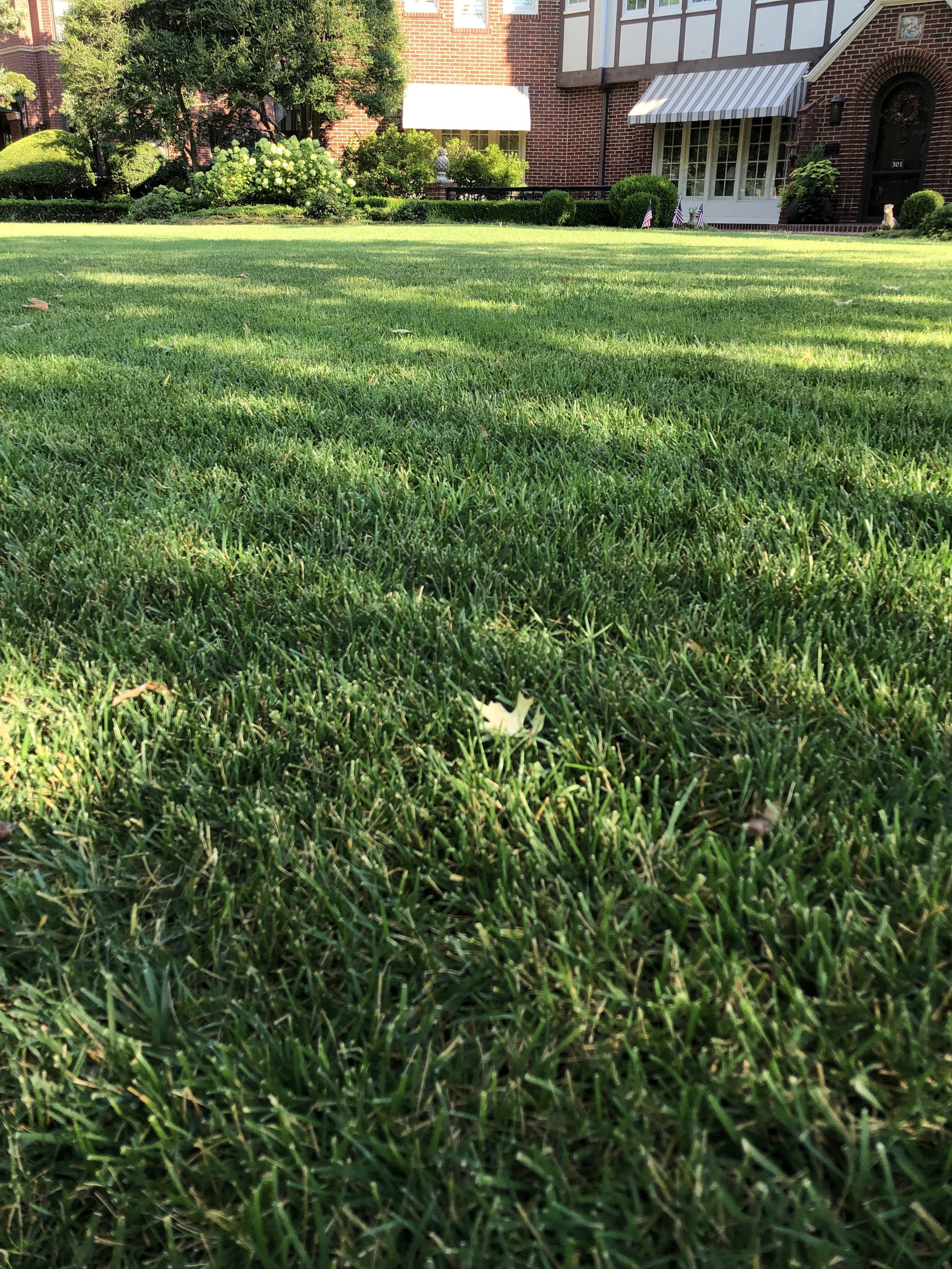When it comes to turfgrass, Oklahoma is blessed to be in the transition zone.
What is the transition zone? It is an area across the middle of the US, where warm-season turf grows in the south and cool-season grasses grow in the north. It is the area of the country where you can choose to grow either warm-season or cool-season grasses.
Bermuda is the common warm-season turfgrass in our region. The advantage Bermuda has is it loves the summer heat and as long as it receives some moisture, it will be at its best in July and August.
But, Bermuda has limits. The biggest being it requires 5-6 hours of direct sunlight to be thick and healthy. Second, it goes dormant in November and doesn’t green up until April, leaving you with a lifeless, straw-brown lawn for months.
Fescue is the cool season alternative. Fescue tolerates more shade and stays green nearly year-round. You can’t beat the deep rich color in the spring and fall. The turf is so soft under your feet. Mowing patterns are sharp. Fescue stays green well into December, keeps some color through the winter, and as soon as the winter starts to break in early March, fescue bursts back to life.
But to be fair, fescue has limits as well. Fescue, because it is a cool season grass, goes through a summer off-season. About the time Bermuda lawns are looking their best, fescue goes through a slump in late July to early August when 95-100 temperatures are common. Growth slows, depth of color fades, and although improved varieties of fescue are relatively drought tolerant, fescue needs water during the summer to stay green.
Early August is the perfect time to evaluate your lawn. If you have a Bermuda lawn, are there areas that are not receiving sufficient light for a thick, healthy Bermuda turf? If you have a fescue lawn, how has it faired through the really wet early July and the heat and lack of rain that followed?
Fescue is best established during September and October. With cooler days and nights just around the corner, now is the best time to evaluate your lawn for the need to establish fescue or add more fescue.
Heavy rain in early July have left many fescue lawns with brown patch damage. If you have fescue areas that look like this area, plan on overseeding this fall.
VERY CRITICAL
Evaluation and decision to seed or not to seed this fall must be made before the first fall pre-emergent application is made in late August through September.
Let’s take a minute to explore ways to use fescue in your lawn…
Fescue in the Shady Areas Only
This is the most traditional approach. Any place where your lawn doesn’t receive at least 6-8 hours of direct sunlight - under trees, on the north side of structures, and those narrow areas between houses and fences - are all prime areas for fescue. Often homeowners put effort into trimming trees in an attempt to get enough light and allow Bermuda to grow. But, in most cases, tree trimming or thinning rarely solves the problem. The best solution is to overseed the areas with fescue in the fall. The negative to “fescue only in the shady areas” approach is a lawn mixed with green and dormant colors during the fall, winter, and early spring.
Full Fescue Lawn
A common myth is fescue won’t grow in full sun. Fescue performs best in dappled shade to partial sun, does very well in full sun when maintained properly, and struggles the most in dense, heavy shade. A full fescue lawn is the best solution for the typical-sized lawn with a few trees making caring for both cool-season and warm-season turf difficult.
Fescue is relatively drought tolerant but needs water during the summer to stay green. This fescue lawn is in mostly full sun and during summer’s drought & heat has been receiving 1.5” of water.
A fescue lawn in dappled sunlight.
Drought stressed fescue should green up once it receives sufficient moisture. If the area is dormant for 5-8 weeks there could be some loss of turf and you should plan on reseeding this fall.
Two Approaches To Managing A Full Fescue Lawn
1. Managing Fescue Over Bermuda
With this approach fertilizing, weed control, mowing, aerating, and overseeding focuses on promoting the fescue and suppressing the Bermuda. Fescue needs heavy fertilizer in the spring and fall, and none in the summer – the exact opposite of Bermuda. Weed control herbicides designed for fescue and not Bermuda are used resulting in Bermuda suppression. Fescue responds well to being mowed taller, 3” to 3 ½”, while Bermuda prefers a shorter height of 2” to 2 ½”. Aeration occurs in the fall, not early summer. And overseeding with fescue in the fall keeps the fescue full and stresses the Bermuda going into the winter.
The negative - You will still notice some Bermuda in the lawn during July and August, but with deep, infrequent watering practices, the fescue will remain the dominant turf.
This is the method I prefer to use on my lawn.
Fescue will loose color in 95+ degree temperatures if it doesn’t receive at least 1.5” of water per week.
2. Full Fescue Only
An aggressive approach to removing Bermuda from the fescue is used. Because Bermuda is the dominant turfgrass in our region it is difficult to have a completely Bermuda-free fescue lawn. If this is your goal, aggressive herbicide treatments in August followed by overseeding in September is required. The negative – Your lawn will look bad before it looks good. There will be a 4-to-6-week period between the first application and when the new fescue grows in. But, you will notice substantially less Bermuda in the next growing season. You can expect to repeat this process every 2 to 3 years to keep Bermuda eradicated.
I have used this process on occasion with success but is not the preferred method due to the poor appearance of the lawn for several weeks until the new fescue grows in.
Fescue growing in full sun over Bermuda.
Fescue with bermuda in August before treatment to control bermuda.
Lawn 2 weeks after treatment to control bermuda.
Fescue 4 weeks after treatment to control bermuda just before overseeding in September.
A fescue lawn in July.
A fescue lawn in the fall.
A fescue lawn in the fall.
As our environment continues to have more and more trees, fescue will become more and more a part of our landscape environment.
Whether you desire to have a full fescue lawn or just need to address the shady areas of your lawn, September through October is the best time to establish fescue from seed. As a cool-season grass, it is much easier for newly established grass to survive the winter.
Spring-seeded fescue typically does not have enough of a root system to survive the summer and is more susceptible to brown patch disease. The best time to seed fescue is in the fall. The second-best time is in the spring, but the chasm between fall and spring is large
If you need help evaluating your need for fescue and would like to discuss your options, please give us a call (405)367-3873
New fescue 30 days after seeding.
Three keys to successful fall fescue seeding:
1. Quality Fescue Blend Seed
2. Aeration for good seed to soil contact.
3. Keeping the seeded area tacky moist until the new seed comes up.
Bonus Tip - Newly seeded grass needs to be kept consistently moist for 2-3 weeks after seeding.
The inability to keep new seed moist is the number one reason new seed fails.
Now is the time to schedule an Irrigation Check to make sure your system is ready for fall overseeding.
Request an inspection today by responding to this email or calling (405)367-3873
A key to successful fescue seeding is keeping the seed moist until it germinates. Check your system now for even coverage to avoid seed failure in dry areas this fall.
VERY CRITICAL
Evaluation and decision to seed or not to seed this fall must be made before the first fall pre-emergent application is made in late August through September.
Lorne Hall
Hall | Stewart Lawn + Landscape
(405)367-3873



















